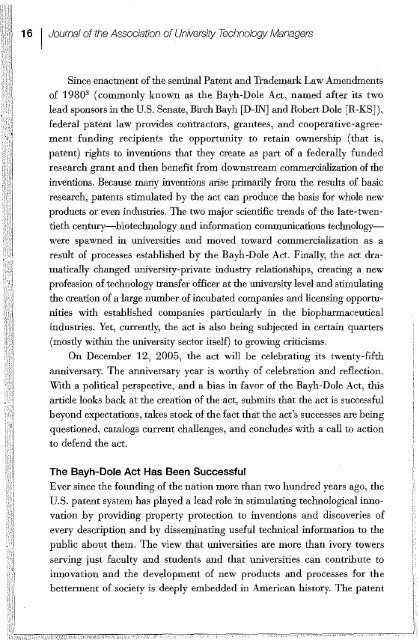~Iri,n - Bayhdolecentral
~Iri,n - Bayhdolecentral
~Iri,n - Bayhdolecentral
Create successful ePaper yourself
Turn your PDF publications into a flip-book with our unique Google optimized e-Paper software.
16 I Journal of theAssociation of University Technology Managers<br />
Since enactment of the seminal Patent and Trademark Law Amendments<br />
of 1980 3 (commonly known as the Bayh-Dole Act, named after its two<br />
lead sponsors in the U.S. Senate, Birch Bayh [D-INJ and Hobert Dole [R-KSJ),<br />
federal patent law provides contractors, grantees, and cooperative-agreement<br />
funding recipients the opportunity to retain ownership (that is,<br />
patent) rights to inventions that they create as part of a federally funded<br />
research grant and then benefit from downstream commercialization of the<br />
inventions. Because many inventions arise primarily from the results of basic<br />
research, patents stimnlated by the act can produce the basis for whole new<br />
products or even industries. The two major scientific trends of the late-twen<br />
tieth century-biotechuology and information communications techuology<br />
were spawned in universities and moved toward commercialization as a<br />
result of processes established by the Bayh-Dole Act. Finally, the act dra<br />
matically changed university-private industry relationships, creating a new<br />
profession of techuology transfer officer at the university level and stimulating<br />
the creation of a large number of incubated companies and licensing opportunities<br />
with established companies particularly in the biopharmaceutical<br />
industries. Yet, currently, the act is also being subjected in certain quarters<br />
(mostly within the university sector itself) to growing criticisms.<br />
On December 12, 2005, the act will be celebrating its twenty-fifth<br />
anniversary. The anniversary year is worthy of celebration and reflection.<br />
With a political perspective, and a bias in favor of the Bayh-Dole Act, this<br />
article looks back at the creation of the act, submits that the act is successful<br />
beyond expectations, takes stock of the fact that the act's successes are being<br />
questioned, catalogs current challenges, and concludes with a call to action<br />
to defend the act.<br />
The Bayh-Dole Act Has Been Successful<br />
Ever since the founding of the nation more than two hundred years ago, the<br />
U.S. patent system has played a lead role in stimulating techuological inno<br />
vation by providing property protection to inventions and discoveries of<br />
every description and by disseminating useful techuical information to the<br />
public about them. The view that universities are more than ivory towers<br />
serving just faculty and students and that universities can contribute to<br />
innovation and the development of new products and processes for the<br />
betterment of society is deeply embedded in American history. The patent
















